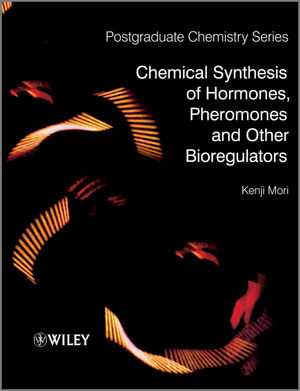Chemical Synthesis of Hormones, Pheromones and Other BioregulatorsISBN: 978-0-470-69724-5
Hardcover
314 pages
September 2010
 Other Available Formats: Paperback
|
||||||
Abbreviations.
1 Introduction—Biofunctional Molecules and Organic Synthesis.
1.1 What are biofunctional molecules?
1.2 Developmental stages of studies on biofunctional molecules.
1.3 Small amounts of the samples are now sufficient for the elucidation of the structures of biofunctional molecules.
1.4 Why must biofunctional molecules be synthesized?
1.5 How can we synthesize biofunctional molecules?
1.5.1 What is synthesis?
1.5.2 What kind of consideration is necessary before starting a synthesis?
1.5.3 Synthon.
1.5.4 Molecular symmetry and synthesis.
1.5.5 Criteria for 'A Good Synthesis'.
1.6 What kind of knowledge and techniques are necessary to synthesize biofunctional molecules?
1.6.1 Stereochemistry and reactivity.
1.6.2 Stereochemistry and analytical methods.
References.
2 Synthesis of Phytohormones, Phytoalexins and Other Biofunctional Molecules of Plant Origin.
2.1 Phytohormones.
2.1.1 What are phytohormones?
2.1.2 Gibberellins.
2.1.3 Diterpenes related to gibberellins.
2.1.4 Abscisic acid and its relatives—synthesis of optically active compounds.
2.1.5 Brassinosteroids.
2.1.6 Phyllanthrinolactone, a leaf-closing factor.
2.2 Phytoalexins.
2.2.1 What are phytoalexins?
2.2.2 Synthesis of pisatin.
2.2.3 Synthesis of 2-(4-hydroxyphenyl)naphthalene-1,8-dicarboxylic anhydride.
2.2.4 Synthesis of oryzalexins 53
2.2.5 Synthesis of phytocassanes.
2.3 Plant allelochemicals.
2.3.1 Synthesis of glycinoeclepin A.
2.3.2 Synthesis of strigolactones.
2.4 Other bioactive compounds of plant origin.
2.4.1 Synthesis of arnebinol.
2.4.2 Synthesis of magnosalicin.
2.4.3 Synthesis of hernandulcin.
2.4.4 Synthesis of O-methyl pisiferic acid.
2.4.5 Synthesis of diospyrin.
2.4.6 Synthesis of mispyric acid.
References.
3 Synthesis of Insect Bioregulators Other than Pheromones.
3.1 Insect juvenile hormones.
3.1.1 What are insect hormones?
3.1.2 Synthesis of juvabione.
3.1.3 Synthesis of the racemates of juvenile hormones.
3.1.4 Synthesis of the enantiomers of juvenile hormones.
3.2 Insect antifeedants.
3.2.1 Synthesis of polygodial.
3.2.2 Synthesis of warburganal.
3.2.3 Synthesis of 3,4-dihydroxypropiophenone 3-β-d-glucopyranoside.
3.2.4 Synthesis of homogynolide A.
3.3 Insect repellents.
3.3.1 Synthesis of rotundial.
3.3.2 Synthesis of polyzonimine.
References.
4 Synthesis of Pheromones.
4.1 What are pheromones?
4.2 Methods for enantioselective synthesis.
4.2.1 Derivation from enantiopure natural products.
4.2.2 Enantiomer separation (optical resolution).
4.2.3 Asymmetric synthesis.
4.2.4 Determination of enantiomeric purity.
4.3 Why is it meaningful to synthesize enantiopure pheromones?
4.3.1 Determination of absolute configuration (1). trogodermal.
4.3.2 Determination of absolute configuration (2). hemiacetal pheromone of Biprorulus bibax.
4.3.3 Determination of absolute configuration (3). sesquiterpene pheromone of Eysarcoris lewisi.
4.3.4 Clarification of the relationship between absolute configuration and pheromone activity—exo-brevicomin.
4.3.5 Clarification of structure (1). lineatin.
4.3.6 Clarification of structure (2). American cockroach pheromone.
4.3.7 Clarification of structure (3). acoradiene.
4.3.8 Clarification of structure (4). himachalene-type pheromone.
4.3.9 Preparation of a pure sample for bioassay (1). disparlure.
4.3.10 Preparation of a pure sample for bioassay (2). japonilure.
4.3.11 Preparation of a pure sample for bioassay (3). pheromone of the palaearctic bee, Andrena wilkella.
4.4 Chiral pheromones whose single enantiomers show bioactivity.
4.4.1 Dihydroactinidiolide, a pheromone component of the red imported fire ant.
4.4.2 Lardolure, the aggregation pheromone of the acarid mite.
4.4.3 Pheromone of the fall webworm moth.
4.4.4 Posticlure, the female sex pheromone of Orgyia postica.
4.4.5 Faranal, the trail pheromone of the pharaoh's ant.
4.4.6 (1S,3S,7R)-3-Methyl-α-himachalene, the male sex pheromone of the sandfly from Jacobina, Brazil.
4.4.7 (S )-9-Methylgermacrene-B, the male sex pheromone of the sandfly from Lapinha, Brazil.
4.4.8 (1S,5R)-Frontalin, the bark beetle pheromone.
4.4.9 (1R,5S,7R)-3,4-Dehydro-exo-brevicomin and (S )-2-sec-butyl-4,5-dihyrothiazole, the pheromone components of the male mouse.
4.5 Chiral pheromones whose stereochemistry–bioactivity relationships are diverse and complicated.
4.5.1 Sulcatol, the pheromone of Gnathotrichus sulcatus.
4.5.2 Sex pheromone components of female German cockroach.
4.5.3 Stigmolone, the pheromone of a myxobacterium Stigmatella aurantiaca.
4.5.4 Ipsenol and ipsdienol, pheromones of Ips bark beetles.
4.5.5 Serricornin, the cigarette beetle pheromone.
4.5.6 Stegobinone, the drugstore beetle pheromone.
4.5.7 Supellapyrone, the sex pheromone of the brownbanded cockroach.
4.5.8 Olean, the sex pheromone of the olive fruit fly.
4.5.9 13,23-Dimethylpentatriacontane as the sex pheromone of a tsetse fly.
4.6 Significance of chirality in pheromone science.
References.
5 Synthesis of Biofunctional Molecules of Microbial Origin.
5.1 Microbial hormones.
5.1.1 A-factor.
5.1.2 Sch II and relatives, the fruiting-inducing cerebrosides.
5.1.3 Basidifferquinone C.
5.1.4 Sclerosporin.
5.1.5 Sporogen-AO.
5.1.6 Differolide.
5.2 Antibiotics.
5.2.1 Ascochlorin.
5.2.2 Ascofuranone.
5.2.3 Trichostatin A.
5.2.4 Koninginin A.
5.2.5 Cytoxazone.
5.2.6 Neuchromenin.
5.2.7 Nocardione A and B.
5.2.8 Cytosporone E.
5.3 Other bioactive metabolites of micro-organisms.
5.3.1 Monocerin.
5.3.2 Pinthunamide.
References.
6 Synthesis of Marine Bioregulators, Medicinals and Related Compounds.
6.1 Marine natural products of ecological importance such as antifeedants.
6.1.1 Stypoldione.
6.1.2 meso- and (±)-Limatulone.
6.1.3 Testudinariol A.
6.1.4 Stellettadine A.
6.2 Marine natural products of medicinal interest.
6.2.1 Punaglandin 4.
6.2.2 Bifurcarenone.
6.2.3 Elenic acid.
6.2.4 Symbioramide.
6.2.5 Penazetidine A.
6.2.6 Penaresidin A and B.
6.2.7 Sulfobacin A, B and flavocristamide A.
6.2.8 Plakoside A.
6.3 Glycosphingolipids and sphingolipids of medical interest.
6.3.1 Esterified cerebroside of human and pig epidermis.
6.3.2 Ceramide B, 6-hydroxylated ceramide in human epidermis.
6.3.3 KRN7000, a glycosphingolipid that stimulates natural killer T cell.
6.3.4 Analogs of KRN7000 prepared in 2003–2006.
6.3.5 Cyclitol, carbasugar and modified d-galactose analogs of KRN7000: RCAI-56 and RCAI-61.
References.
7 Synthetic Examination of Incorrectly Proposed Structures of Biomolecules.
7.1 Origin of incorrect or obscure structures.
7.2 Structure fabrications of historical interest.
7.2.1 Kogl's auxin-a and -b, the plant-growth promoters.
7.2.2 Chemical communication system of the green flagellate, Chlamydomonas.
7.2.3 Early fabrications of the structures of insect pheromones.
7.3 Incorrect structures resulting from inappropriate use of purification or analytical methods.
7.4 Inappropriate structural proposal caused by problems in bioassay methods.
7.4.1 Blattellastanoside A and B, putative components of the aggregation pheromone of the German cockroach.
7.4.2 2,2,4,4-Tetramethyl-N,N-bis(2,6-dimethylphenyl)cyclobutane-1,3-diimine as a putative antifeedant against the cotton boll weevil.
7.5 Human errors are inevitable in chemistry, too.
References.
8 Conclusion—Science as a Human Endeavor.
8.1 Small molecules are also beautiful.
8.2 Continuous efforts may bring something meaningful.
8.3 Can a scientist eventually have a hope in the future?
Acknowledgements.
Index.



